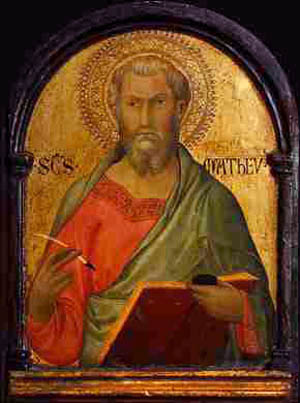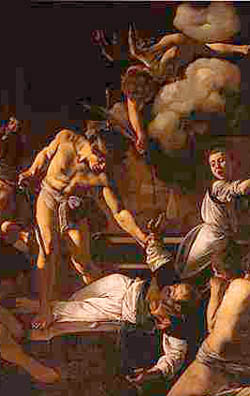 |
The Saint of the Day
St. Matthew – September 21
Prof. Plinio Corrêa de Oliveira
Biographical selection:
The Apostle St. Matthew evangelized Ethiopia, where he disclosed as agents of the Devil the various magicians who misled the King and the people. He resurrected the son of the King, and the admiring people wanted to adore him as a god. But St. Matthew did not permit it and used the gold and silver they brought in his homage to build a great church. He resided there under the protection of the sovereign for 33 years. The king’s daughter, St. Ephigenia [Feast day also September 21], consecrated herself to God and founded a convent where she was the superior of more than 200 virgins.

St. Matthew, Apostle of Ethiopia
|
The King died, and his successor, Hirtacus, wanted to marry St. Ephigenia since he considered her the only woman worthy of him. The new King asked St. Matthew to convince the Princess to marry and promised him half of his kingdom if he should succeed. The Apostle told him to come to church on Sunday, and that there he would find a response to his request. The King hastened to comply, thinking that the Apostle would persuade Ephigenia to marry him. With the virgins and whole populace present, St. Matthew preached at great length on the excellence of the sacrament of marriage.
Hirtacus was pleased believing that the sermon would make Ephigenia consent to marriage with him. However, at a certain moment, St. Matthew said:
"Since marriage is good as long as the union is kept inviolate, all of you here present know that if a servant dared to usurp the king’s spouse, he would deserve not only the king’s anger, but death as a penalty."
Then he turned to the king and addressed him:
“So it is with you, O King! You know that Ephigenia has become the spouse of the Eternal King and is consecrated with the sacred veil. How can you take the spouse of One who is more powerful than you and make her your wife?”
Filled with rage and hatred, the King left the church. When the Mass was concluded, he sent a swordsman with the order to kill St. Matthew. Finding St. Matthew standing before the altar with his hands raised to Heaven in prayer, he stabbed the Apostle in the back, killing him and making him a martyr.
Learning of this, the indignant people ran to the royal palace to take revenge for that crime, but the priests restrained them and advised them to follow the funeral of the Saint instead. Hirtacus then had a huge fire ignited around the convent of St. Ephigenia to kill her and the virgins. But St. Matthew appeared to them and turned the fire away from the convent and towards the royal palace, which was completely consumed along with all in it. Only the King and his son managed to escape.
The Prince immediately ran to the tomb of St. Matthew confessing his father’s crimes and asking forgiveness. The King was stricken with a loathsome leprosy and took his life with his own sword. The people chose as king the brother of Ephigenia. He reigned for 70 years spreading the cult of Christ and building churches throughout Ethiopia. (From the Golden Legend)
Comments of Prof. Plinio:
First, we should notice that Ethiopia had a special character of those countries of ancient Africa. It was one of the first to become Catholic and develop a strong personality. Later, unfortunately, it became Monophysist. Until some time ago, Ethiopia was an Empire. The Golden Legend tells us how the King and the people of Ethiopia had been led astray by magicians from the worship of the true God that one can have by faithfulness to Natural Law. Those magicians had a pact with the Devil. St. Matthew destroyed their power showing the King and the people that they were agents of the Devil.
We can imagine the scene of the Publican Jew, Matthew, arriving in that country by sea, or perhaps by the Nile, and beginning to preach. We can envision how the magicians felt a great power in St. Matthew that came from God, and feared him. The selection is brief on this point, but we can suppose that they probably performed many tricks with miraculous hues to convince the people that they had a divine power. St. Matthew arrived and shortly afterward resurrected the son of the King. With this, he confounded the magicians before the King and the people. Seeing this noble, powerful, supernatural, and amiable man perform such a miracle, the Ethiopian multitude was filled with admiration and became enthused with him.

The Martyrdom of St. Matthew
by Caravaggio
|
One of the great natural qualities of the black race is their capacity to admire. Grace elevates and develops this quality. The capacity to admire is such a beautiful thing that, from a certain point of view, I believe it is more beautiful than the capacity to be admired. In Heaven for all eternity we will admire, we will adore Our Lord. Then, we can imagine those Ethiopians exercising this gift, enthused with St. Matthew, and asking him to baptize them.
Second, the conversion of the daughter of the King is very beautiful, as well. A nation that lived for centuries in Paganism and impurity was converted by the words of St. Matthew, and 200 ebony young ladies went with the daughter of the King to a convent to be spouses of Our Lord Jesus Christ. They resided near Ethiopia’s first church built under the direction of St. Matthew himself. The convent that received those 200 ebony virgins was also near the royal palace. Probably, in a special ceremony, St. Matthew gave them a symbol of their consecration, the veil, to begin their religious life. We can imagine the influence this episode had on the people, and the joy of God and His Angels in Heaven seeing these Catholic institutions born in Ethiopia. It is a wonderful thing!
Third, it is interesting to note the agility of St. Matthew. When the Apostle began to preach, the King thought he would obtain the hand of St. Ephigenia in marriage. But then St. Matthew turned the sermon around, and solemnly condemned the sovereign.
Another curious point, the priests advised the people not to destroy the royal palace, but directed them to St. Matthew’s funeral. But apparently the Saint did not agree with this advice, because he deviated the fire from the convent to burn the royal palace, chastising its inhabitants and doing more or less what the people would have done if the priests hadn’t stopped them.
Fourth, the final sentence of the selection affirms that the new King reigned for 70 years spreading the Catholic Faith and building churches. This transmits an idea of a long, peaceful, and elevated kingdom. It is the peace of Christ in a kingdom of Christ. When the Catholic Faith is established, it is the seed of every good. When it is not established, the seed of every evil is sown.
Some say that the Golden Legend would not be true because the stories it tells are too marvelous. My first inclination is to think the opposite: if it is marvelous, it would be true.
Let us ask St. Matthew to give us the intrepid faith he had that made him able to convert a whole kingdom single-handed and to establish the seed of Christendom in Ethiopia. Like him we should be Apostles of the End Times bringing entire countries to Our Lord and Our Lady.


  | | Prof. Plinio Corrêa de Oliveira | |
The Saint of the Day features highlights from the lives of saints based on comments made by the late Prof. Plinio Corrêa de Oliveira. Following the example of St. John Bosco who used to make similar talks for the boys of his College, each evening it was Prof. Plinio’s custom to make a short commentary on the lives of the next day’s saint in a meeting for youth in order to encourage them in the practice of virtue and love for the Catholic Church. TIA thought that its readers could profit from these valuable commentaries.
The texts of both the biographical data and the comments come from personal notes taken by Atila S. Guimarães from 1964 to 1995. Given the fact that the source is a personal notebook, it is possible that at times the biographic notes transcribed here will not rigorously follow the original text read by Prof. Plinio. The commentaries have also been adapted and translated for TIA’s site.
|
Saint of the Day | Home | Books | CDs | Search | Contact Us | Donate

© 2002- Tradition in Action, Inc. All Rights Reserved
|
 |

|